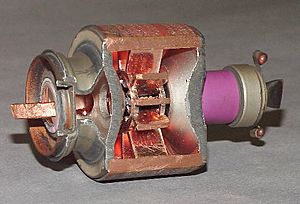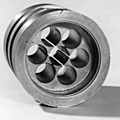Cavity magnetron facts for kids
The cavity magnetron is a special kind of vacuum tube. It creates microwaves, which are a type of radio wave. It does this by using a stream of tiny particles called electrons. These electrons interact with a magnetic field.
Inside the magnetron, electrons move past small holes, called cavities. This movement causes a special effect called resonance. It's a bit like blowing air across the top of a flute to make a specific sound. This resonance is what creates the microwaves.
The 'resonant' cavity magnetron was invented in 1940. Two scientists, John Randall and Harry Boot, created it. This invention was very important because it could produce powerful pulses of microwaves. This made radar much more useful.
Radar systems using the cavity magnetron could detect smaller objects. The magnetron also made radar sets much smaller. This meant they could fit into aircraft and ships. They were used to find things like submarines during wartime. Today, cavity magnetrons are still used in many microwave ovens and in different radar systems.
How a Cavity Magnetron Works
A cavity magnetron has a central part called a cathode. This cathode sends out electrons. Around the cathode is a ring of metal, called the anode. The anode has several small holes or cavities inside it.
A strong magnetic field is also present. This field makes the electrons move in a spiral path. As the electrons spiral, they pass by the openings of the cavities. This movement causes the electrons to give up their energy.
The energy given off by the electrons creates microwaves. These microwaves then travel out of the magnetron. They can be used for cooking food or for sending out radar signals.
History of the Magnetron
Before the cavity magnetron, there were other types of magnetron tubes. But they were not powerful enough for many uses. John Randall and Harry Boot developed the cavity magnetron in 1940. They worked at the University of Birmingham in England.
Their invention was a big step forward. It helped the Allies in World War II. The powerful microwaves it produced were perfect for radar. This allowed them to spot enemy aircraft and ships from far away.
The small size of the magnetron was also a huge advantage. It meant radar could be used on smaller vehicles. This included airplanes and ships that hunted submarines.
Modern Uses
Today, the cavity magnetron is still a very important device.
- Microwave Ovens: This is its most common use. The magnetron creates the microwaves that heat food quickly.
- Radar Systems: It is still used in many radar applications. This includes weather radar, air traffic control radar, and some military radar systems.
Images for kids
-
An older 9 GHz magnetron tube and magnets from a Soviet aircraft radar. The tube fits between two horseshoe-shaped alnico magnets. These magnets create a magnetic field along the tube's axis. Microwaves come out from the opening at the top. Modern tubes use smaller rare-earth magnets.
-
A split-anode magnetron from around 1935. On the left is the tube itself, about 11 cm tall. On the right, it is set up between the poles of a strong permanent magnet.
-
A drawing of a cavity magnetron from 1984. Part of the magnet and copper block are cut away. This shows the cathode and cavities inside. This older magnetron uses two horseshoe-shaped alnico magnets.
-
Sir John Randall and Harry Boot's original cavity magnetron. They developed it in 1940 at the University of Birmingham, England. It is now in the Science Museum, London.
See also
 In Spanish: Magnetrón para niños
In Spanish: Magnetrón para niños











